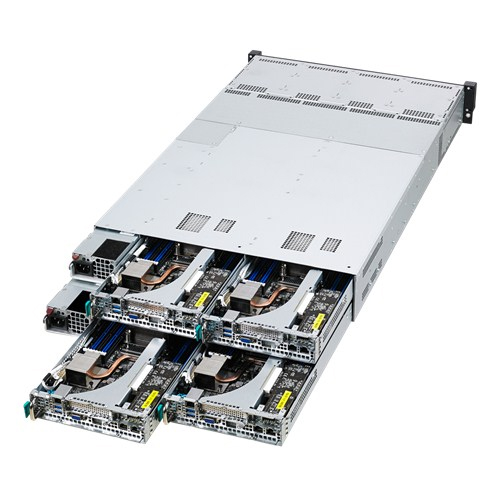Best on-premises hardware options for hybrid cloud

For organizations looking to leverage a hybrid cloud model, the on-premises hardware solution is just as important -- if not more so -- than the public cloud provider. Unlike cloud computing resources that can be provisioned on demand, the initial investment for physical servers is comparatively high, with a hardware lifecycle that's substantially longer as well.
This guide examines a cross-section of options available for the on-premises hardware in your hybrid cloud deployment. While not an exhaustive look at all hardware options from every possible vendor, it will highlight the benefits and drawbacks of potential hardware options for hybrid cloud.
SEE: HPE private clouds get Azure-powered hardware boost
Building your own servers

A barebones rack server kit from ASUS: the RS720Q-E8-RS12.
The relatively laborious task of building your own servers is the DIY counterpart to the managed hardware aspect of the public cloud -- and one that' s likely to be the easiest to do on a tight IT budget. Although it's possible to purchase standalone server motherboards, opting for a barebones kit that includes a standard rack case with mounting options, like the ASUS RS720Q-E8-RS12 for performance applications or the ASUS RS740-E7-RS24-EG for data storage, is a more easily managed solution than assembling a completely custom arrangement. (This may also reduce the 'IKEA effect' of being too closely attached to things you build yourself.) Other vendors in this space include Intel, Gigabyte, and SuperMicro.
Opting for a barebones kit also provides the flexibility of picking individual components based on personal preference. For example, for RAM, some people prefer bigger names like Micron / Crucial, while others prefer products from Mushkin, which are assembled in the United States.
Building the server has the added benefit of freeing you from obligatory software licenses from hardware vendors, allowing you to use your preferred software options for various tasks. Often, these are open-source solutions. For instance, open-source CMIS servers such as NemakiWare offer a significant savings over closed-source solutions like IBM FileNet or Microsoft SharePoint, which may be bundled with hardware licenses or other server software.
Buying servers from a hardware vendor
Building your own servers offers fuller control over each individual component, but some features can be realized only with prebuilt systems from traditional hardware vendors, like HP Enterprise, Dell, and Lenovo. For example, the Moonshot blade server design by HP Enterprise offers a space-efficient solution with the Moonshot chassis -- which combines power, cooling, networking, and management functions that can be shared between 45 hot-pluggable server cartridges. With the server-cartridge model, you can add more computing resources to scale with workload growth without increasing the complexity of the on-premises architecture. This does, however, create a dependency on the vendor, as there are no third-party cartridges.
HP's Moonshot 1500 chassis accommodates up to 45 server cartridges like the Xeon E3-based m710p.
One unusual feature of Moonshot is the diversity of processor types available as server cartridges. The m710p server cartridge uses a traditional, though mid-grade, Intel Xeon E3-1284Lv4 processor, supports up to 32GB of DDR3L RAM, and supports M.2 2280 SSDs. For lower-power needs, the m300 server cartridge uses an Intel Atom C2750 processor and can use slim 7.5mm 2.5-inch SATA solid-state drives or traditional hard drives. The m700 server cartridge uses an AMD Opteron X2150 APU and can be ordered with 32 or 64GB of integrated flash storage, as well as the use of the M.2 drive for removable SSDs.
In addition to Intel and AMD offerings for x86-64 processors, the m400 server cartridge offers an octa-core 64-bit ARMv8 CPU -- specifically, the AppliedMicro X-Gene. Because of differences in memory controllers, the m400 can use 16 GB SO-DIMM modules, giving it a maximum RAM capacity of 64GB. Naturally, deployments with dependencies on Windows Server can't utilize processor architectures other than x86-64.
For high-performance computing, the OpenPOWER Foundation was created by IBM to foster an ecosystem around the POWER8 architecture with third-party server offerings from companies such as TYAN and Cirrascale to complement POWER8 servers available from IBM. Through the foundation, IBM is seeking to challenge the hegemony of Intel's Xeon processors for high-performance computing, claiming that POWER8 servers top the price performance charts and that they offer an average 2.3x higher performance for financial workloads.
SEE: Cloud IT infrastructure spending to reach $33.4 billion in 2015: IDC
Buying servers from a solutions vendor
Fujitsu's M10 SPARC servers are designed for organisations in Oracle's database ecosystem.
IT solutions vendors can offer customized and tightly integrated hardware and software systems that connect to your cloud vendor with minimal configuration and setup time. Solutions vendors like Fujitsu and NetApp provide easy-to-deploy systems that bring many of the ease-of-use benefits of the the public cloud to your on-premises infrastructure -- although at the cost of some degree of vendor lock-in and yearly software licenses.
Fujitsu's server offerings include standard rackmount and blade servers, as well as SPARC servers for users in the Oracle ecosystem. What sets Fujitsu apart as a solutions vendor, rather than as a hardware vendor, are products like the ETERNUS CD10000, which can be scaled up to 56 petabytes. While this is probably excessive for a hybrid cloud model, the approach is important. The ETERNUS uses Ceph rather than RAID, as rebuilds with this number of disks are completely impractical. Fujitsu offers the ServerView Resource Orchestrator and related software, like Cloud Services Management, for managing the balance between on-premises and cloud computing resources.
NetApp offers its own unique solutions, which leverage public cloud providers like AWS, Google, and Azure (among others) for storage and computing requirements. Cloud ONTAP allows users to leverage AWS as a virtual storage appliance, with the entire NetApp suite handling tasks such as thin provisioning and deduplication to decrease storage costs and increase performance.
Also see: